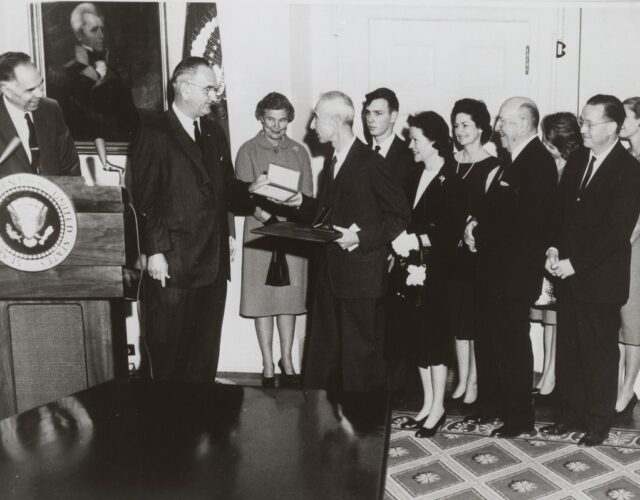Charles Thorpe. Oppenheimer: The Tragic Intellect. Chicago: University of Chicago Press, 2006. 384 pp. $25.00 paper.
The American theoretical physicist J. Robert Oppenheimer (1904–1967) was often called the father of the atomic bomb for his leadership at the Los Alamos Laboratory during World War II. Almost equally well known is Oppenheimer’s public humiliation in the spring of 1954, when the Personnel Security Board of the Atomic Energy Commission (AEC) concluded hearings, transcripts of which were leaked to the press and published in their entirety, that declared Oppenheimer a national security risk no longer worthy of top-secret security clearance. After 1954 Oppenheimer continued to serve as director of the Institute for Advanced Study in Princeton, where he had moved in 1947. There he often engaged with colleagues in questions of physics that had been the focus of his research in the 1920s and 1930s in quantum electrodynamics, nuclear physics, and astrophysics. He also gained attention for his speeches as a public intellectual well versed in art, poetry, and literature. For many Americans at midcentury, Oppenheimer and Albert Einstein were the two great scientist intellectuals of the 20th century.
Around the time of the 2004 centenary commemoration of Oppenheimer’s birth, a set of first-rate and detailed new biographies of Oppenheimer appeared, among them ones by Kai Bird and Martin J. Sherwin, David Cassidy, and Priscilla McMillan, as well as Silvan S. Schweber’s dual study of Oppenheimer and Hans Bethe. It might thus be tempting to put off reading Charles Thorpe’s 2006 book Oppenheimer: The Tragic Intellect, but this would be a mistake. Thorpe’s volume is an original and compelling analysis of Oppenheimer’s life and role as a scientific leader. It is what Thorpe terms a sociological biography and addresses head-on the characterizations of Oppenheimer by both friends and enemies as someone who lacked a firm and dependable identity. Indeed, Oppenheimer himself said during the 1954 AEC hearings that he had very little sense of self.
Somewhat surprisingly, Thorpe grounds Oppenheimer’s very success as a scientific leader at Los Alamos in his flexible identity united with a brilliant mind. Thorpe’s explanation for this leadership is not psychological but sociological, citing Oppenheimer’s leadership as a collective accomplishment resulting from collaborative work by members of the laboratory. If Oppenheimer shaped Los Alamos, he equally was shaped and transformed by it. Many of Oppenheimer’s colleagues initially were surprised and skeptical at General Leslie Groves’s decision to place the 38-year-old Oppenheimer in charge of the laboratory that would make the bomb. Through the interventions and coaxing of colleagues, among whom Thorpe especially highlights I. I. Rabi and Robert Bacher, Oppenheimer became the right man for the job. Crucial to this process, in Thorpe’s view, was Oppenheimer’s “changeling quality” that enabled him to mediate between different groups and interests in the emerging techno-scientific national security state of the 1940s, listening to every opinion, summarizing and weighing different views flawlessly, and making things work efficiently and quickly.
Thorpe ties Oppenheimer’s effectiveness as a leader among scientists to his conception of the scientific community as an organic body with its own traditions, values, and modes of social control, rooted in apprenticeship, fellowship, and the free exchange of ideas. Thorpe finds troubling, however, Oppenheimer’s claim to a highly personal role, made possible by Groves, as the conduit or mediator between the atomic scientists on the one hand and the military and government on the other. What Thorpe criticizes is the emergence of Oppenheimer’s attitude, during roughly 1941 to 1953, that physicists should not waste time on moral and political questions and that scientists should return to a prewar ethos of the purity of the scientific calling and its independence from social claims or responsibilities.
Like many of the scientists associated with the Manhattan Project, Oppenheimer concluded after Hiroshima and Nagasaki that the atomic bomb had made future wars unthinkable and that arms control had to be an ultimate goal, but not one that ordinary scientists were responsible for effecting. In 1965 he rephrased his famous comment, made in a 1947 lecture at the Massachusetts Institute of Technology, that physicists have known sin. He said that he had meant that scientists have known the sin of pride and of thinking they knew what was good for man: “This is not the natural business of a scientist” (p. 286). In Thorpe’s view, Oppenheimer offered to weep for the world but not to help change it.
Finally, like many other Oppenheimer biographers, Thorpe places the rise and fall of Oppenheimer within the framework of Cold War politics and the new status of science as a vital resource of state violence and power. Following the war, with the exception of his initial resistance to development of the hydrogen bomb within the General Advisory Committee (GAC) of the AEC, Oppenheimer largely cooperated with government committees on matters of atomic policy and national security, including anti-Communism investigations. His own affiliations with left-wing and Communist-linked organizations in the 1930s had long placed him under FBI and Army Security surveillance, but Oppenheimer had left all this behind by 1941.
After he had been eased out of some government committees and had resigned from the GAC in 1952, Oppenheimer published an article in July 1953 in Foreign Affairs criticizing the over-reliance of the United States on nuclear weapons and a strategy of mass destruction that could end civilization. Like Bird and Sherwin, Thorpe sees in the Foreign Affairs article a red flag that warned the Eisenhower administration that Oppenheimer, when he no longer served as a political insider in atomic-policy deliberations, might become an external critic to whom the public attributed insider status. This was another reason to distrust him.
In the end the AEC revoked Oppenheimer’s security clearance in 1954, on the stated grounds of character defects that were allegedly proven in the course of the hearings. For the broader public, in Thorpe’s view, a key lesson in the hearings’ outcome was that scientists’ authority within the American polity should be strictly limited. If Oppenheimer had expressed moral or political qualms about the development of the hydrogen bomb, he should not have done so nor should he have been asked to do so. His alleged moral defects of character only confirmed the general conviction among the public of scientists’ inability and unsuitability to address questions outside their special areas of technical expertise. For Thorpe, then, the tragedy of Oppenheimer was a tragedy both for the American political system and for the American scientific community; scientists were instructed that their role was not to be one of the public intellectual concerned with transcendent moral and political questions. They were but technical experts. The independent cultural authority of science, in Thorpe’s view, was to be sacrificed to the requirements of the science- and technology-based national security state.




